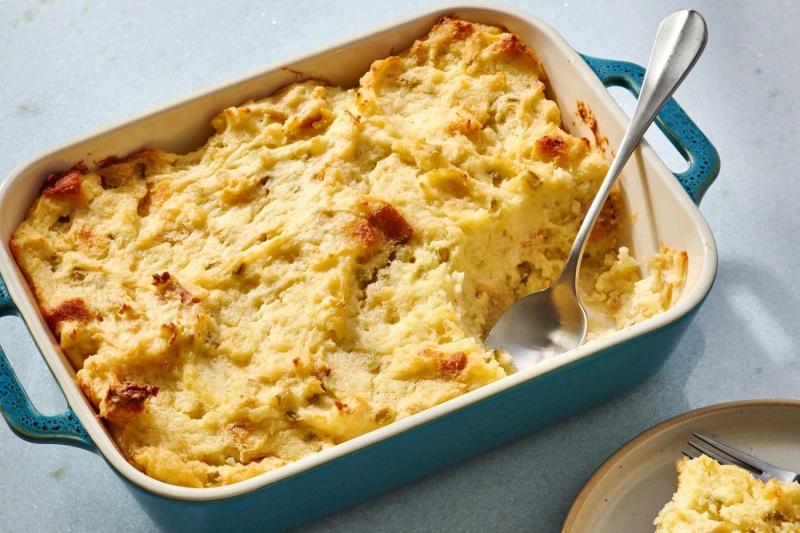It’s like if mashed potatoes and stuffing had a baby.
Prep: 60 mins
Cook: 45 mins
Total: 105 mins
Servings: 10 to 12 servings
Yield: 1 (9×13)-inch
Rooted in southeastern Pennsylvania, potato filling is a quintessential side dish most often found in Schuylkill, Lebanon, Lehigh, and Berks Counties. One could describe the starchy side as dressed-up mashed potatoes, or the potato version of bread stuffing, aka dressing.
While the recipe is a staple on Thanksgiving tables, “filling” as my family calls it, is an ideal accompaniment for Sunday dinners or holiday sit-downs at any time of year. My grandmother prepared the dish every Turkey Day and sometimes on other special occasions, or when she had a hankering for it. I was usually by her side pretending to help, while ultimately getting my fill of filling—a mingling of mashed potatoes, toasted bread, and sweated-down onions and celery—hours before dinner was served.
After I became an adult and started to explore the world of cooking on my own, bread stuffing replaced filling on my Thanksgiving table. I hadn’t cooked or eaten potato filling in years, but when I returned home to Pennsylvania during the pandemic, my mom and I prepared the time-honored dish. I didn’t realize how much I missed my grandmother’s potato filling until I found myself licking the spoon and running my finger around the bowl’s rim, scraping up the remnants yet again.
The History of Potato Filling
Pennsylvania Dutch potato filling has deep roots and has graced plates for centuries. German immigrants began arriving in the southeastern part of the state in the late 1700s. A budget-friendly, satisfying potato-rich diet inspired recipes like filling. Nowadays, potato filling is still a beloved dish in the region and can be found on tables across southeastern Pennsylvania, especially during the holiday season.
Filling Variations
In Lebanon County, or the state’s “Saffron Belt,” filling often has a yellow tinge, as it’s colored with saffron threads, a highlight in many regional recipes. Some recipes call for parsley to introduce a smidge of green and earthiness to the potatoes.
What To Serve With Potato Filling
On our Thanksgiving table, potato filling was typically served with turkey, corn, butter beans, jellied cranberry sauce, and gravy, an optional garnish. But potato filling would be delicious with roasted duck, green beans, and candied sweet potatoes. Or pair it with Cornish hen and a mélange of other root vegetables.
No matter what our meal included, filling seemed to be everyone’s favorite side dish. Our spread always had at least two deep containers packed with potato filling so we could indulge in a second helping and sometimes, a third. That said, it never hurts to make extra.
Tips for Making Potato Filling
- By hand or machine—You can use an electric mixer or a hand masher.
- Make it creamy but not runny—If the consistency of the filling isn’t creamy enough, add small amounts of milk while mixing.
- Veggies should be a golden color—Be careful not to brown the vegetables too much.
- Use white bread—Wonder bread or similar works best.
- The egg is optional—The addition of one egg makes the potatoes slightly creamier and richer, but feel free to leave it out if desired. Its absence will not hurt the dish.
Make Ahead
To avoid stress on the holiday, consider preparing the filling one day in advance, but hold off on baking it. Refrigerate the casserole overnight and bake it before Thanksgiving dinner.
“If you can’t decide between roasting or mashing your potatoes for the holidays (or any time of year), this incredible alternative turns a side dish into something that can stand on its own. I’d recommend a generous grind of black pepper to compliment the vegetable-infused flavor.” —Noah Velush-Rogers
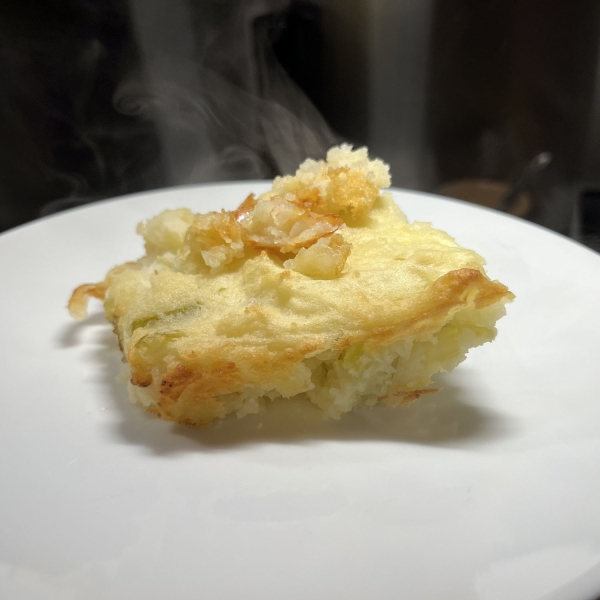
A Note From Our Recipe Tester
Ingredients
-
3 pounds russet potatoes, peeled and quartered
-
Fine salt, as needed
-
1/2 cup plus 2 tablespoons unsalted butter, divided, more for the dish
-
1 yellow onion, diced
-
5 celery ribs, trimmed and diced
-
2 slices white bread
-
1 cup milk, more as needed
-
1 large egg, beaten
Steps to Make It
-
Gather the ingredients. Position a rack in the center of the oven and heat to 350 F. Butter a 9 x 13-inch casserole dish.
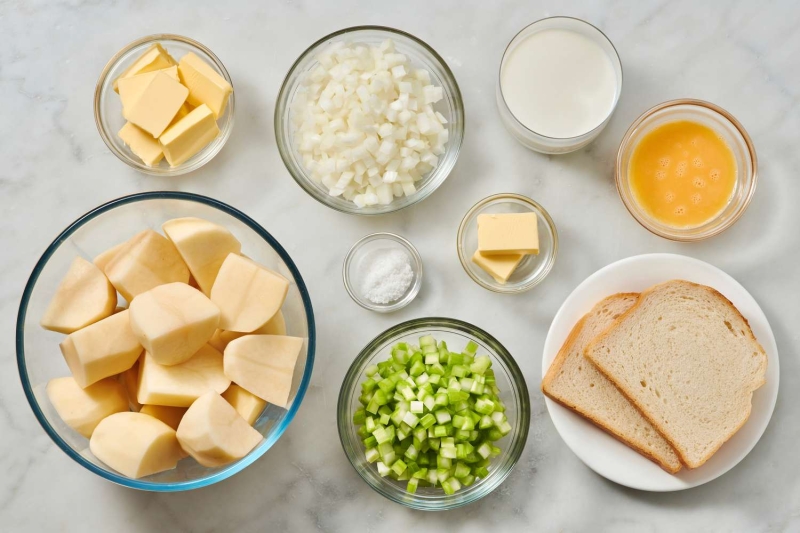
-
Add 3 pounds russet potatoes, peeled and quartered, to a large pot of well-salted water. Bring the water to a boil and then reduce it to a simmer.
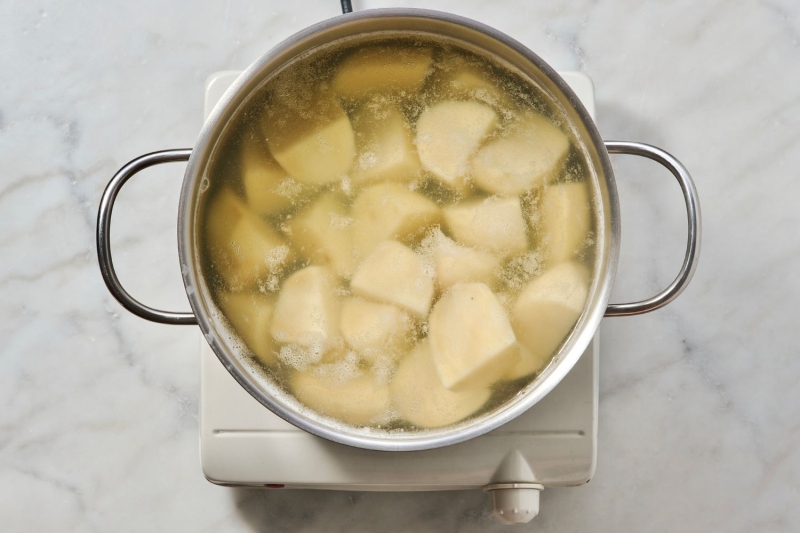
-
After 10 minutes, try piercing a few potatoes with a fork. They should be soft but not fall apart. If needed, simmer for 5 more minutes. Once tender, drain the potatoes in a colander and set aside.
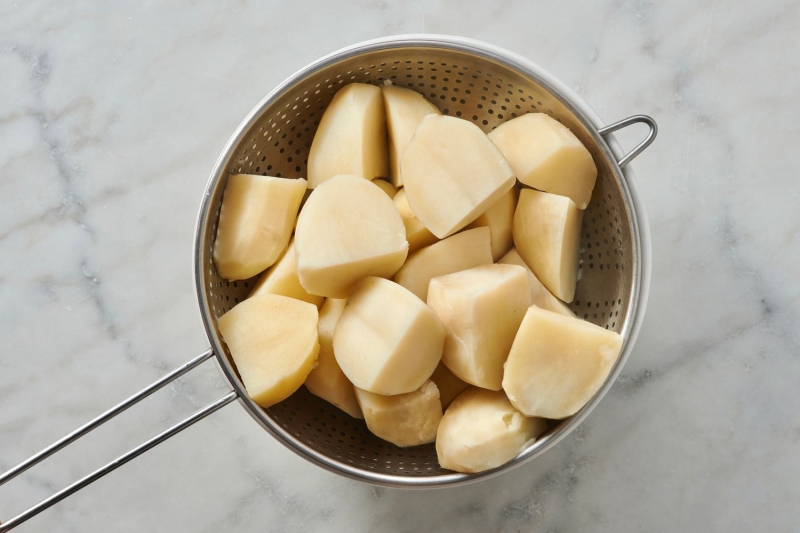
-
Melt 1/4 cup (4 tablespoons) unsalted butter in a large nonstick skillet over medium heat. Add 1 medium onion, diced and 5 medium celery ribs, trimmed and diced to the pan, stirring often. The vegetables will begin to work up a sweat and turn soft. Reduce the heat to medium-low and continue to sauté, stirring constantly, until the veggies turn a light golden color, 15 to 20 minutes. Set aside.
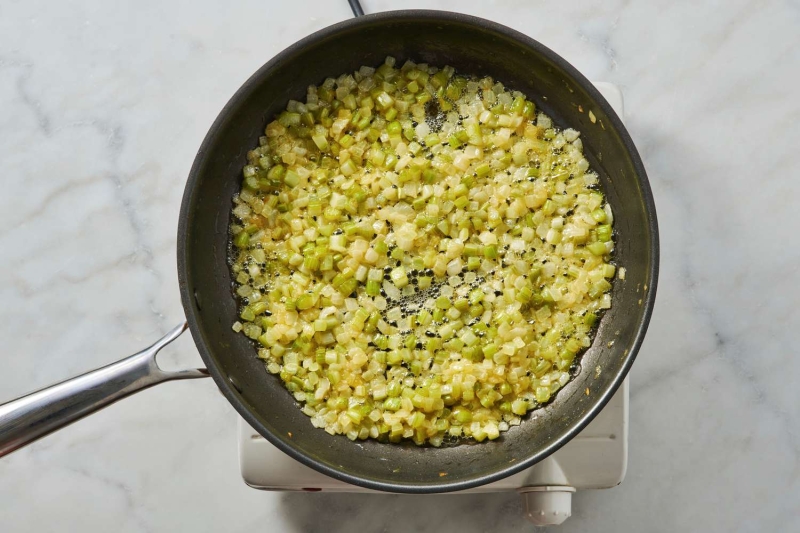
-
Toast 2 slices white bread until light brown (be careful not to go too dark or the burnt flavor will permeate the filling). Using a bread knife, cut the bread into 1/2-inch cubes. Set aside.
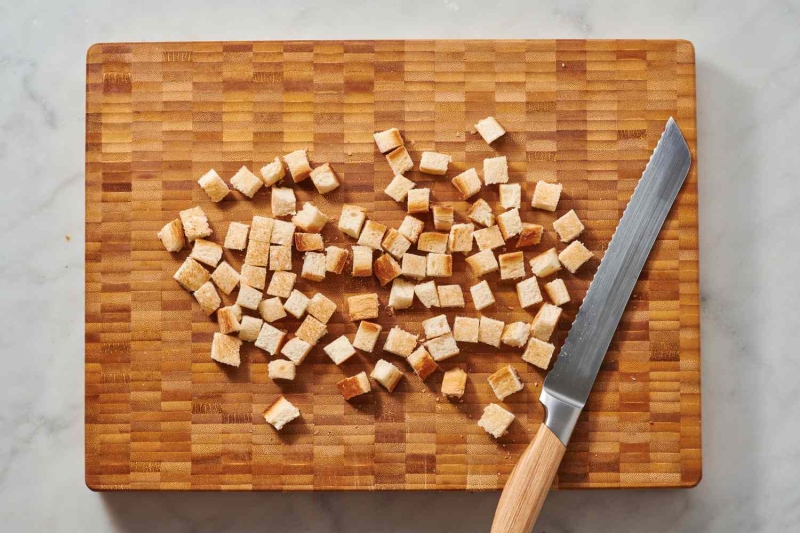
-
Now it’s time to mash the potatoes. Melt 1/4 cup (4 tablespoons) unsalted butter in a small skillet.
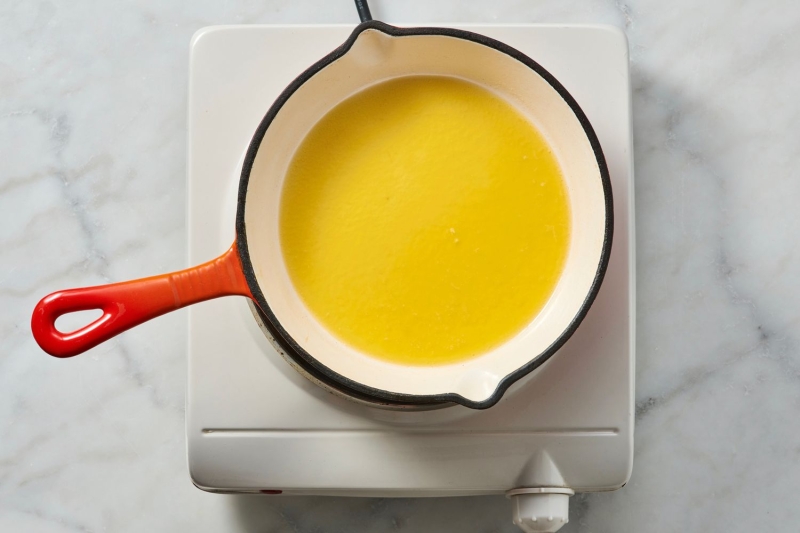
-
Place the drained potatoes in a large bowl. Mash by hand or with a mixer or ricer, depending on your preference. Add the melted butter and continue to mash and mix. Add 1 cup milk to the potatoes 1/4 cup at a time until the potatoes are fully mashed and creamy.
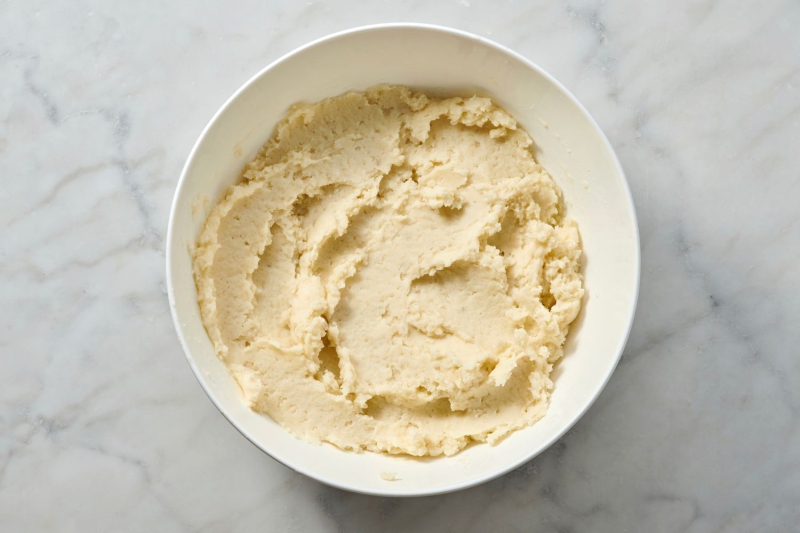
-
Spoon the sauteed onion and celery into the potatoes and mix until combined. Taste the potato mixture and add more salt if needed.
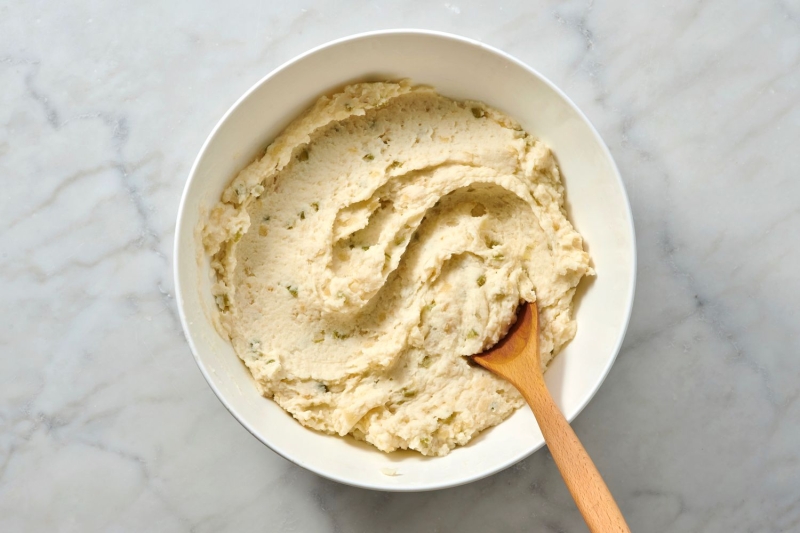
-
Add 1 large egg, beaten and the cubed bread to the potatoes and combine with a wooden spoon. The bread will create texture, so you will probably need to add more milk. Add small amounts at a time. Be careful not to add too much milk or the mixture will be watery.
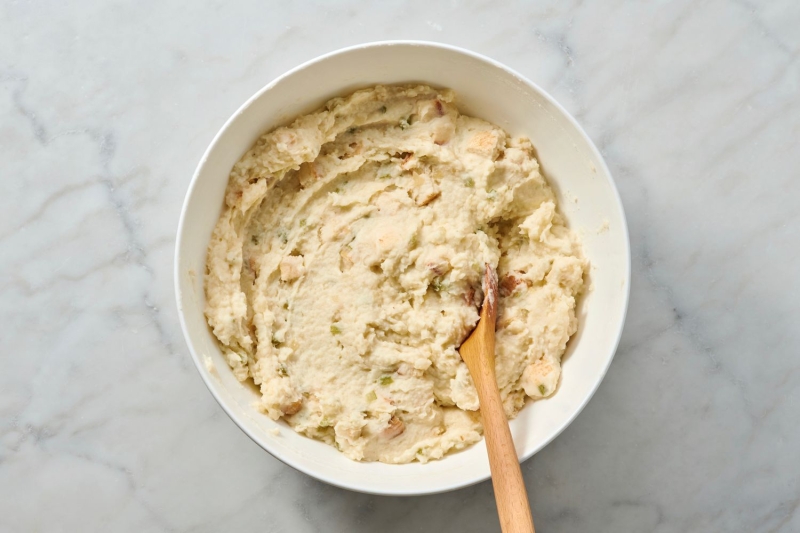
-
Spoon the filling mixture into the prepared casserole dish. Cut the remaining 2 tablespoons unsalted butter into pieces and place on top of the potatoes.
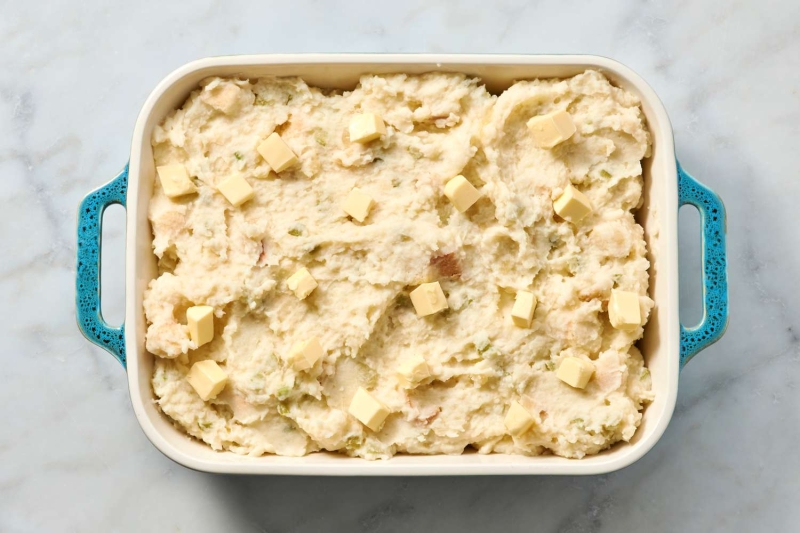
-
Bake until light golden brown, about 45 minutes. Serve immediately.
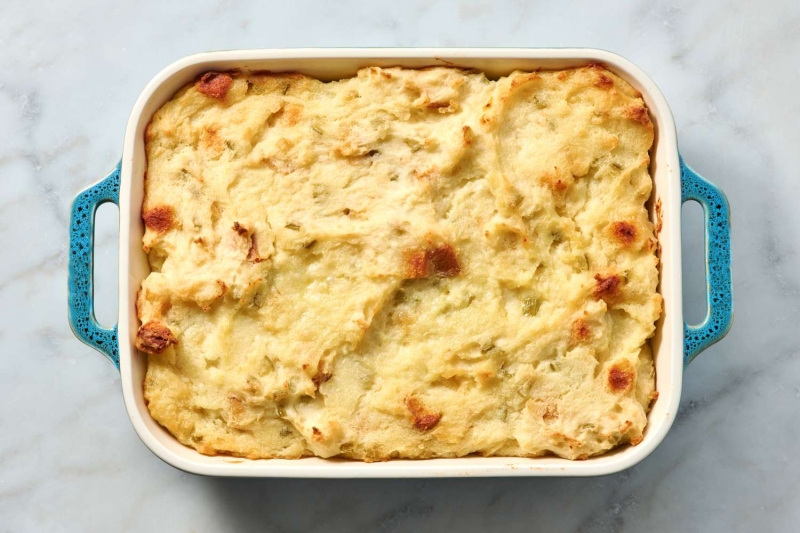
How To Store
Potato filling can be refrigerated in an airtight container for up to three days. Cover with foil and reheat in the oven until the internal temperature registers at least 165 F on a digital thermometer.
Feeling Adventurous? Try This:
- Even more carbs—For a more bread-like or dressing consistency, double the bread.
- Add saffron—For a golden color and subtle saffron flavor, add 1/4 teaspoon saffron threads to the milk and let steep for 15 to 30 minutes before mixing the milk into the potatoes.
- Add some greenery—For some visual interest and fresh flavor, you can add up to 1/2 cup finely chopped fresh parsley to the potato filling.
| Nutrition Facts | |
|---|---|
| Servings: 10 to 12 | |
| Amount per serving | |
| Calories | 229 |
| % Daily Value* | |
| Total Fat 11g | 14% |
| Saturated Fat 6g | 32% |
| Cholesterol 42mg | 14% |
| Sodium 72mg | 3% |
| Total Carbohydrate 29g | 11% |
| Dietary Fiber 3g | 11% |
| Total Sugars 3g | |
| Protein 5g | |
| Vitamin C 11mg | 54% |
| Calcium 67mg | 5% |
| Iron 2mg | 9% |
| Potassium 727mg | 15% |
| *The % Daily Value (DV) tells you how much a nutrient in a food serving contributes to a daily diet. 2,000 calories a day is used for general nutrition advice. | |
